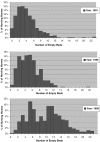Nursing home spending patterns in the 1990s: the role of nursing home competition and excess demand
- PMID: 16033491
- PMCID: PMC1361180
- DOI: 10.1111/j.1475-6773.2005.00394.x
Nursing home spending patterns in the 1990s: the role of nursing home competition and excess demand
Abstract
Objective: To examine nursing home expenditures on clinical, hotel, and administrative activities during the 1990s and to determine the association between nursing home competition and excess demand on expenditures.
Data sources/study setting: Secondary data sources for 1991, 1996, and 1999 for 500 free-standing nursing homes in New York State.
Study design: A retrospective statistical analysis of nursing homes' expenditures. The dependent variables were clinical, hotel, and administrative costs in each year. Independent variables included outputs (inpatient and outpatient), wages, ownership, New York City location, and measures of competition and excess demand.
Data collection/extraction method: Variables were constructed from annual financial reports submitted by the nursing homes, the Patient Review Instrument and Medicare enrollment data.
Principal findings: Clinical and administrative costs have increased over the decade, while hotel expenditures have declined. Increased competition was associated with higher clinical and administrative costs while excess demand was associated with lower clinical and hotel expenditures.
Conclusions: Nursing home expenditures are sensitive to competition and excess demand conditions. Policies that influence competition in nursing home markets are therefore likely to have an impact on expenditures as well.
Figures
Similar articles
-
Changes in clinical and hotel expenditures following publication of the nursing home compare report card.Med Care. 2010 Oct;48(10):869-74. doi: 10.1097/MLR.0b013e3181eaf6e1. Med Care. 2010. PMID: 20733531
-
Excess demand and cost relationships among Kentucky nursing homes.Health Care Financ Rev. 1994 Summer;15(4):137-52. Health Care Financ Rev. 1994. PMID: 10138482 Free PMC article. Review.
-
The effect of competition on nursing home expenditures under prospective reimbursement.Health Serv Res. 1988 Oct;23(4):555-74. Health Serv Res. 1988. PMID: 3141316 Free PMC article.
-
The effects of ownership and ownership change on nursing home industry costs.Health Serv Res. 1996 Aug;31(3):327-46. Health Serv Res. 1996. PMID: 8698588 Free PMC article.
-
New estimates of lifetime nursing home use: have patterns of use changed?Med Care. 2002 Oct;40(10):965-75. doi: 10.1097/00005650-200210000-00013. Med Care. 2002. PMID: 12395029
Cited by
-
Medicaid capital reimbursement policy and environmental artifacts of nursing home culture change.Gerontologist. 2014 Feb;54 Suppl 1(Suppl 1):S76-86. doi: 10.1093/geront/gnt141. Gerontologist. 2014. PMID: 24443609 Free PMC article.
-
The effect of state regulatory stringency on nursing home quality.Health Serv Res. 2012 Oct;47(5):1791-813. doi: 10.1111/j.1475-6773.2012.01459.x. Epub 2012 Sep 4. Health Serv Res. 2012. PMID: 22946859 Free PMC article.
-
Effects of state minimum staffing standards on nursing home staffing and quality of care.Health Serv Res. 2009 Feb;44(1):56-78. doi: 10.1111/j.1475-6773.2008.00906.x. Epub 2008 Sep 17. Health Serv Res. 2009. PMID: 18823448 Free PMC article.
-
Explaining differences in remuneration rates of nursing homes in Germany.Eur J Health Econ. 2014 May;15(4):401-10. doi: 10.1007/s10198-013-0483-2. Epub 2013 May 11. Eur J Health Econ. 2014. PMID: 23665795
-
The impact of hospital-based skilled nursing facility closures on rehospitalizations.Health Serv Res. 2013 Apr;48(2 Pt 1):499-518. doi: 10.1111/1475-6773.12001. Epub 2012 Oct 4. Health Serv Res. 2013. PMID: 23033808 Free PMC article.
References
-
- Anonymous . The National Nursing Home Survey: 1999 Summary. Vital and Health Statistics. Hyattsville, MD: National Center for Health Statistics; 2002. Series 13. No. 152. - PubMed
-
- Dye AN. Characteristics of Elderly Nursing Home Residents: Data from the 1995 National Nursing Home Survey. Advance Data from Vital and Health Statistics. Hyattsville, MD: National Center for Health Statistics; 1997. No. 289. - PubMed
-
- Gertler P, Waldman DM. “Quality Adjusted Cost Functions and Policy Evaluation in the Nursing Home Industry.”. Journal of Political Economy. 1992;100:1232–56.
-
- Grannemann W, Brown S, Pauly MV. “Estimating Hospital Costs: A Multiple Output Analysis.”. Journal of Health Economics. 1986;5:107–27. - PubMed
-
- Harrington C, Swan JH, Nyman J, Carrilo H. “The Effect of Certificate of Need and Moratoria Policy on Change in Nursing Home Beds in the United States.”. Medical Care. 1997;35(6):574–88. - PubMed
Publication types
MeSH terms
Grants and funding
LinkOut - more resources
Full Text Sources
Medical


